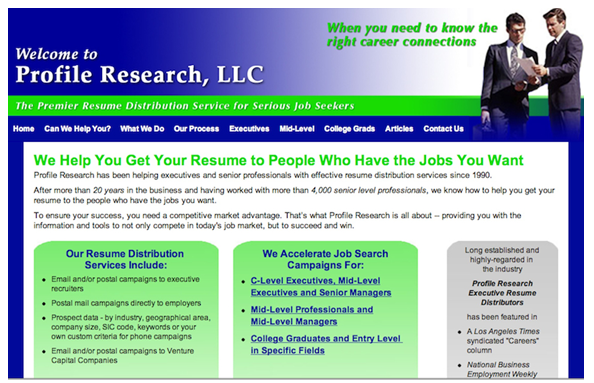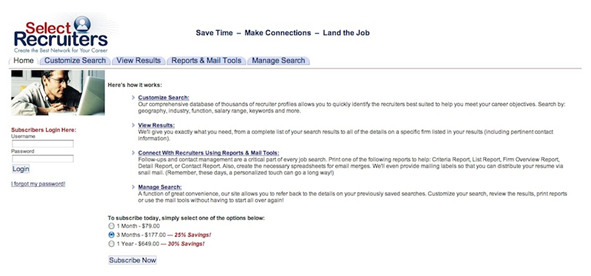By investing in a professionally written résumé, you’re already positioned yourself ahead of other jobseekers. But don’t let that advantage go to waste. Now that you have your résumé, what should you do with it?
This guide will give you strategies for what you can — and should — do with your résumé to maximize your chances of finding and securing your next job.
Apply for Positions
Of course, this is the most common use for your new résumé. Where most jobseekers fall short, however, in maximizing their résumé, is that they simply use the résumé to apply for positions they see advertised — on job boards and company websites, in newspapers and trade journals, and through recommendations from friends.
When applying for positions, don’t just send in your résumé and hope for a callback. Instead, maximize your chances of securing an interview by making a personal contact within the company. You can use online networking sites like LinkedIn, BranchOut, and Glassdoor to identify possible contacts. You may find that you already know someone who works for the employer (or you know someone who knows someone), or you can identify a hiring manager by name by researching the company. (Start with a simple Google search, and check out the company’s website.)
Don’t stop with simply applying for jobs you see advertised. You can also use the résumé to apply for unadvertised positions. This involves researching companies you’d like to work for, finding a contact at the company (again, using LinkedIn, BranchOut, and Glassdoor), and sending your résumé with an introductory letter outlining why you’d like to work for the company. When you have a clear picture of the type of position you want — and the company you’d like to work for — it gives you a real direction for your job search. You know who to target and where to apply, and if you’re approaching a company that isn’t currently advertising an opening, you’re also not competing with dozens — or hundreds, or thousands — of other jobseekers.
If you don’t already have a list of your “dream employers,” you can compile one by asking yourself the following questions:
- What industry is my target employer in?
- What kind of company do I want to work for? (public, private, nonprofit? Startup or well-established company?)
- Do I want to work for a small company, a larger employer — or somewhere in between? (Identify size by number of employees – 1 to 20, 21 to 50, 51-100, more than 100, more than 500?)
- Ownership structure: Do I want to work for a family-owned company? A sole proprietorship? A multinational company with an international parent company? A franchise? A company with a centralized ownership group? A corporate entity?
- Where do I want to work (geographic preferences — like a particular city or state, or even companies within a certain proximity to your home). Do I want to work for a company that offers telecommuting, so it doesn’t matter where I live in relation to where the company is located?
- What about company culture? (An organization’s culture is defined as “widely shared values that provide unity and cooperation to achieve common goals.”) What is important to me in terms of the company’s mission, commitment to employees, sense of fun, emphasis on learning, leadership style, systems and processes, recruiting/hiring methodology, etc.
Next, clarify your ideal job — what is the position you’d most like to have?
- What are possible job titles for the type of position I want? (The same position might have different names at different companies; the more job titles you can identify for the type of work you want to do, the easier it will be for you to research your dream opportunity.)
- What is a typical day like in your ideal position? Would it involve meetings? Would you be working independently on projects, as part of a team, or both? Would they be short-term projects, or long-term projects?
- What type of reporting structure would you prefer? Who would you report to? Who would report to you?
- How much would you be making in this position? Compensation can be an important consideration. Don’t just identify a target salary — remember that benefits and other non-cash compensation are part of the total package.
Armed with the information you’ve distilled about your ideal job and your ideal company, you can go about finding possible opportunities.
How can you research these companies?
The simplest way to start your research is on a search engine, like Google or Bing. Google the company. Visit their website, but also look for news releases they’ve published (these can spotlight new products and services that might lead to new job opportunities in the near future), and links to trade industries and other sources that can give you additional insight into the company from third parties. Publicly-traded companies also must file all kinds of disclosure documents. You can search the U.S. Securities and Exchange Commission’s EDGAR database for some of these documents:
http://www.sec.gov/edgar/searchedgar/webusers.htm
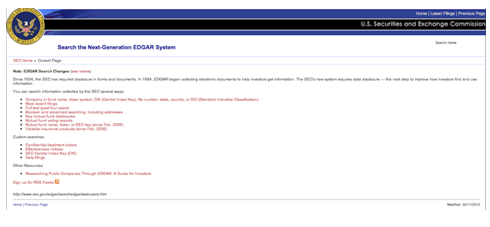 Glassdoor is another excellent resource for “insider” company research. You can learn about the company from current and former employees.
Glassdoor is another excellent resource for “insider” company research. You can learn about the company from current and former employees.
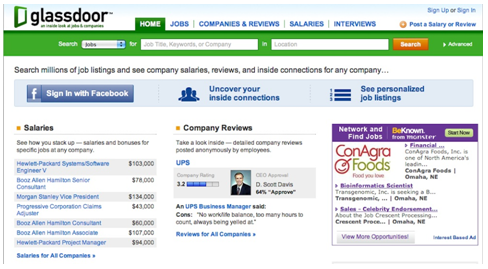
In the green bar at the top of the home page of the site, select “Companies” from the drop-down menu to locate information on a specific employer. (Membership in Glassdoor is free, as long as you contribution information to their database.)
Other ideas:
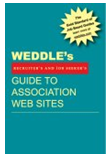 Find trade groups and associations within an industry, and look for participating companies. Then, check out the directory of members to identify possible employers. How can you find these groups? You can conduct a Google search, check on LinkedIn for people in similar industries and see what Groups they belong to, or use the ASAE’s free online search directory (http://www.asaecenter.org/Community/Directories/associationsearch.cfm). You can also purchase a book like “WEDDLE’s Guide to Association Web Sites” ($49.95) available online from WEDDLE’s bookstore. (Now in its fourth edition, the reference guide lists web sites for more than 3,000 associations, including whether the site offers a job board, résumé database, discussion forum, and/or bulletin board).
Find trade groups and associations within an industry, and look for participating companies. Then, check out the directory of members to identify possible employers. How can you find these groups? You can conduct a Google search, check on LinkedIn for people in similar industries and see what Groups they belong to, or use the ASAE’s free online search directory (http://www.asaecenter.org/Community/Directories/associationsearch.cfm). You can also purchase a book like “WEDDLE’s Guide to Association Web Sites” ($49.95) available online from WEDDLE’s bookstore. (Now in its fourth edition, the reference guide lists web sites for more than 3,000 associations, including whether the site offers a job board, résumé database, discussion forum, and/or bulletin board).
Search the Yellow Pages (or the online equivalent) and make a list of potential employers to research further. If you can identify the Standard Industrial Classification (SIC) code or North American Industry Classification System (NAICS) code for an industry, you can search for companies within that classification that meet your criteria. (SIC and NAICS codes are assigned by the U.S. government to identify the primary business of the company, and these classifications cover all types of economic activities, including agriculture, forestry, fishing, hunting, mining, construction, manufacturing, transportation, communications, utility, trade, finance, insurance, real estate, personal and business services, repair, recreation, and public administration.) You can use the U.S. Census Bureau’s website to research and look up SIC and NAICS codes: http://www.census.gov/eos/www/naics/)
Research possible employers using mailing list/database companies. Running a search on companies using a site like InfoUSA (http://www.infousa.com/) can not only help you generate a target list of employers, but you can also purchase the data in the form of a mailing list or email list, which you can then use to make contact for unadvertised opportunities.
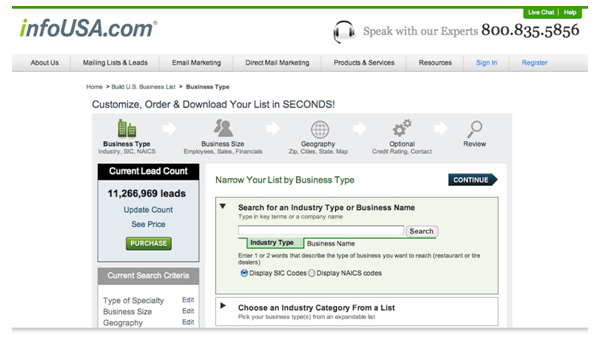
Applying for positions — whether advertised or unadvertised — is the top use for your résumé once you have it. But it’s certainly not the last item on your “to do” list.
Get Your Résumé in the Hands of a Recruiter
Working with a recruiter may be one strategy you consider in your job search. You may be approached by a recruiter (sometimes called a “headhunter”), or you may wish to make contact yourself. While you may find your next job through a recruiter, it’s important to understand that recruiters aren’t in the business of finding jobs for jobseekers — instead, they are in the business of making a match between what their client (the employer) needs, and the candidate (jobseeker) they want to place in a job opening.
Jobseekers do not pay fees to search firms. Recruiters are paid by the companies who hire them to fill a position. Because search firms don’t work for you (the jobseeker), don’t expect them to be overly responsive when you contact them. If you are a fit for a current or future opening, they may add you to their database of candidates. You will hear back from them if they have a position that fits your qualifications, or to ask you to recommend other people who might be interested in the job. Otherwise, you probably won’t hear from them at all.
There are different types of recruiters, and it’s important to understand the differences.
- Internal Recruiters / In-House Recruiters / Corporate Recruiters. These individuals work for the employer and are usually a part of the human resources staff. They only facilitate placements of candidates within their organization. (They don’t place candidates for positions outside of their employer.)
- Contingency Recruiter. This recruiter is only paid if the candidate they want to place is hired by the client organization (thus the use of the word “contingent” in the title). They are paid on commission for job placements. If their candidate isn’t hired, they don’t get paid. Contingency recruiters most often work for employment agencies and staffing firms.
- Retained Recruiter. These individuals are paid by the client company regardless of whether or not their candidate is hired. These recruiters are most likely to help place candidates in six-figure jobs, and may handle extremely sensitive (confidential) placements, like for large public companies as well as high-profile university or sporting organization positions.
Approximately two-thirds of all recruiters are contingency recruiters, while the remaining one-third are retained recruiters. Retained firms are hired by a client company for a specific assignment for a specific amount of time — typically, 90 to 120 days. Usually, only one search firm is hired by the client company for a job opening. Retained recruiters are more often used to fill high-level positions (salaries of $100,000 and above). The search firm will assemble a short list of candidates that will be presented to the client company.
Contingency firms are typically used for positions in the $40,000 to $100,000 range. Because contingency recruiters are paid only when their candidate is selected (and hired!), they are competing with other recruiters to provide candidates for each assignment. Keep in mind that you might be one of several candidates being presented by your recruiter to the client company. Remember that if you are trying to keep your job search quiet, you may not want your résumé widely distributed by the recruiting firm — something that may happen if you work with contingency recruiters. Be sure to talk with your recruiter about this. You can work with more than one recruiter at a time — however, be sure to let the recruiters know you are working with other recruiters so they don’t present you for the same position. This can result in a situation where you are not considered at all for the opening, because the client company doesn’t want to get in the middle of a fight between recruiters about who deserves the commission.
Remember: the recruiter is paid by the employer, not the jobseeker. This means that the recruiter is looking for the best fit between the client’s needs and the jobseeker’s qualifications. Recruiters will not place candidates looking to make a career change. Instead, the recruiter is usually working from a list of requirements: years of experience in the position/field, certifications, special skills, competency in specific areas (i.e., computer applications), fluency in a specific language, degrees or specific training, etc. If you’re not a match, you won’t be recommended to the prospective employer.
When making contact with a recruiter about an advertised opportunity, make sure you meet at least 90% of the requirements listed for the position. Otherwise, you’re wasting your time — and the recruiter’s time — because “the match” is critical. If you don’t meet the criteria, you won’t make the cut. Recruiters — especially contingency recruiters — only present candidates who are “hire-able,” because they won’t get paid if they don’t make the placement.
How can you find recruiters?
The simplest answer is: Many times, recruiters will find you. If you have an up-to-date profile on LinkedIn and a desirable list of skills, it’s not unusual for you to be contacted by a recruiter who would like to place you with a client company.
LinkedIn is also a great way to locate recruiters who work in your field or your geographic area. You can use LinkedIn’s People Search function to find a contact. 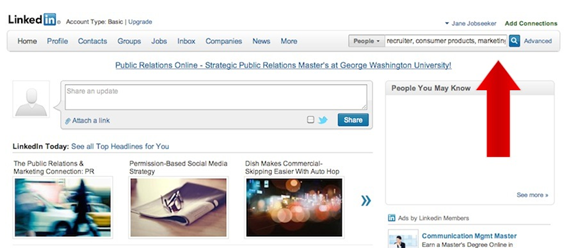
For example, you may type in: recruiter, consumer products, marketing, Sacramento and the search will yield results you can review to find potential recruiter contacts. Reputable recruiters will have LinkedIn profiles outlining their career and accomplishments and defining the type of clients and candidates they work with. You should also review their Recommendations and see what their clients and candidates say about them.
When you want to connect with a recruiter, a good place to start is with your colleagues. Ask if they have worked with a recruiter who was helpful and who treated them with respect and professionalism. Human resources managers and recruiting directors often can be a good source of recruiter referrals as well. Ask “Who is the best recruiter you’ve worked with?”
You can also look at job postings from recruiters on the major job boards (Monster, CareerBuilder, etc.) as well as industry-specific job boards. See which recruiters have posted positions similar to the one you’re seeking.
You can also make connections with recruiters by joining and participating in LinkedIn Groups.
Google’s search engine can also help you mine the LinkedIn database to find a match. For example, use the following search query (replacing “Chicago area” with the location of your choice): Site:linkedin.com ~recruiter “Chicago area”
If you want to save yourself the time and trouble of researching recruiters and making contact with one recruiter at a time, consider a service like Profile Research, LLC. You can develop a targeted list of recruiter contacts by industry, geographic area, or keywords and your résumé will be distributed to the recruiters directly.
These companies also provide similar services:
Success rates for using résumé distribution services are difficult to gauge. Even though you have a stellar résumé, you may find you get very little response to an unsolicited distribution. Other jobseekers have found these services to be very effective, yielding contacts with hiring managers and recruiters who are either currently advertising open positions, or who may be receptive to learning more about a candidate. Depending on the amount you invest in the service, you may find it to be extremely cost-effective as a job search strategy.
When evaluating a service, ask:
- How do you get the contacts for your résumé distribution service? Are these opt-in contacts? (Are the people receptive to receiving résumés?)
- Do you send the résumé to everyone on your list, or do you target the résumés to specific keywords to ensure the recipient only gets résumés they would be interested in?
- Do you specialize in a particular industry?
- Do you have testimonials or references from clients who have worked with you and had success using your services? What is your success rate?
You can also build your own list using two tools from Kennedy Information, LLC:
The first is the “Directory of Executive and Professional Recruiters.”
Available in paperback from Amazon.com, or online at recruiterredbook.com, the “Directory of Executive and Professional Recruiters” provides detailed listings about contingency and retained recruiters across 120+ industries and 84 job functions. An online edition is available for $59.95 for a one-year subscription. If you purchase a print edition of the Directory, you can also receive six months of free access to the online edition.
The listing will give you contact information for the recruiting firm, including email address and website (when available). It will also let you know which type of recruiting firm it is (contingency or retained) — and whether there is a salary minimum for candidates they work with. Many search firms will also provide a description or summary of their services or specialties, including job functions and industries they serve. Some search firms will also describe the type of services they offer in addition to recruiting — including career management, management consulting, outplacement, and/or temporary and contract staffing.
Kennedy Information also offers its “Select Recruiters” service, which allows jobseekers to customize a search to target recruiters. It is available in one-month, three-month, and one-year subscriptions.
You can use the “Select Recruiters” service to create reports and spreadsheets to create email and snail mail (print) merges.
Use Your Résumé To Update Your LinkedIn Profile
Your LinkedIn profile should align with your résumé, although the two should not be exactly the same. The work history listed in your profile should definitely match up with your résumé — this is an easy check for prospective employers to make. However, your profile should complement — not duplicate — your résumé.
The most important pieces of your LinkedIn profile are your profile Headline and your LinkedIn Summary. These two things are the first items a prospective employer will review. While the résumé uses third-person language, your LinkedIn Summary should be a first-person narrative that appeals to a prospective employer’s needs by identifying what makes you a good candidate.
You should also use the same accomplishments that are on your résumé in your LinkedIn profile, although you can elaborate on them a bit more in the Experience section. If you’ve prepared Challenge-Action-Result (CAR) statements for interviews, you may want to integrate these your LinkedIn profile in the Experience section.
Finally, make sure your LinkedIn profile is complete. Post your photo, fill out all of the sections (including current and former positions and your education), populate the Skills & Expertise section, and request (and offer) Recommendations. LinkedIn profiles that are “complete” receive 40% more opportunities than incomplete profiles.
Get a Copy to All Your Networking Contacts
There have been several studies that say that up to 60% of jobs are filled through networking. You can ask people for information and advice, or ask them if they know of any job openings. If you are conducting an open job search (that is, you’re not trying to keep your job search quiet from your current employer), the more people you tell you’re searching, the more likely you are to find your next opportunity.
The more connections you make, the easier it will become. Whether mentioning your job search in casual conversation, or making calls or sending emails specifically to advance your job search, you will find that people want to help you, if they can. But you will get the best results if you ask for something specific. For example, “Do you know anyone who works at ‘Company X’” instead of, “Do you know anyone who is hiring?”
Who Should You Get Your Résumé To?
- Personal Contacts: friends, relatives/cousins, neighbors, parents of your children’s friends, parents of your friends, relatives of your friends, everyone on your Christmas card list
- Community Contacts: civic and political leaders, clergy, chamber of commerce members, librarians
- Club Members: social club, country club, swim club, health club, town club, other fans of your favorite sports team, collecting club, sports club, professional associations, trade association members, job search club members, sorority/fraternity contacts
- Professional Contacts: your accountant, physician, real estate agent, financial advisor, attorney, banker, dentist, insurance agent, travel agent, mortgage broker
- Work Contacts: current and previous co-workers and managers, employees of competitor companies, customers, vendors, suppliers, salespeople, former co-workers or other contacts in your industry who are retired, venture capitalists
- Educational contacts: people you meet at conferences, conventions, seminars, and workshops, current and former classmates (elementary, middle, high school, college, graduate school), PTA members, former professors, college career center staff, alumni association contacts, coaches, school advisors, adult education course teachers
Get a Copy to All Your References
In addition to your networking contacts, make sure you also get a copy of your résumé to anyone who you want to be a reference for you in your job search.
Prepare your references to be contacted by your prospective employer. In addition to having your current copy of your résumé, you should contact each of your references and let them know when you are scheduled for an interview (and double-check their contact information to make sure it is up-to-date) — and be sure to call them right after the interview to let them know they may be contacted to check your references.
The Final Step
The last thing you should do with your new résumé is commit to keeping it updated. If you don’t already have one, start a “brag” file. This can be a file folder or a folder on your computer that you use to collect items for updating your résumé. This can include descriptions of projects (and quantifying accomplishments related to those projects in terms of numbers, percentages, and dollars), performance reviews, testimonials or letters of appreciation from customers, awards/honors, training certificates, publications you’ve contributed to, etc.
And finally, put a note on your calendar for next year at this time to update your résumé.
